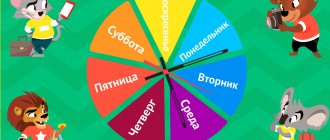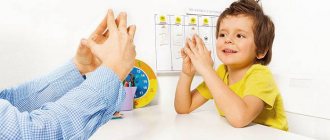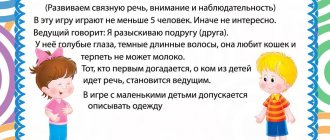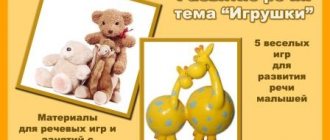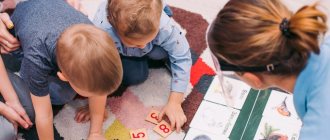Didactic games for the development of the syllabic structure of words.
.
To make it easier for a child to learn the structure of a word, a speech therapist needs to involve as much physical activity as possible, since with movement the child will better consolidate speech material. Words of different syllabic structures can be clapping, tapping, jumping, stepping away, and so on.
At the preparatory stage
Exercises are carried out first on a non-verbal level, and then on a verbal one.
Exercise “Repeat the same”
Goal: learn to reproduce a given rhythm. Materials: ball, drum, tambourine, metallophone, sticks. Progress of the exercise: The speech therapist sets the rhythm with one of the objects, the child must repeat the same.
Exercise “Count correctly”
Goal: learn to count sounds. Materials: children's musical and noise instruments, cards with numbers, cube with dots. Progress of the exercise: Option 1. The child claps his hands (knocks on a tambourine, etc.) as many times as there are dots on the cube. Option 2. The speech therapist plays sounds, the child counts them and picks up a card with the corresponding number.
Exercise “Choose a scheme”
Goal: learn to correlate the rhythmic pattern with its diagram on the card. Material: cards with patterns of rhythmic patterns. Progress of the exercise: Option 1. The speech therapist sets a rhythmic pattern, the child selects the appropriate pattern on the card. Option 2. The child reproduces a rhythmic pattern according to a given pattern.
Exercise “Long - short”
Goal: to learn to distinguish between long and short sounding words. Material: chips, long and short strips of paper, pictures. Progress of the exercise: Option 1. The speech therapist pronounces the words, the child places a chip on a long or short strip. Option 2. The child names the words in the pictures and puts them into two groups: the long strip and the short one.
At the correctional stage
the work was carried out at the verbal level with the obligatory “switching on” of the auditory, visual and tactile analyzers.
Exercises at the sound level:
1. “Say the sound A as many times as there are dots on the cube. Make the sound O as many times as I clap my hands.”
2. “Find out what sound (series of sounds) I made.” Recognition by silent articulation, pronunciation with voice.
3. Determination of a stressed vowel in a stressed position (in a series of sounds).
Exercises at the syllable level:
– Pronounce a chain of syllables while simultaneously stringing rings onto a pyramid (building a tower from cubes, rearranging pebbles or beads). – “Fingers say hello” - pronouncing a chain of syllables by touching the fingers of the hand with the thumb on each syllable. – Count the number of syllables pronounced by the speech therapist. – Name the stressed syllable in the chain of heard syllables. – Memorizing and repeating chains of different types of syllables.
Word level exercises:
Ball game
Goal: learn to clap the syllabic rhythm of a word. Material: ball. Progress of the game: the child beats the rhythm of the word given by the speech therapist with a ball.
Game "Telegraph"
Goal: to develop the ability to divide words into syllables. Material: sticks. Progress of the game: the child “transmits” the given word by tapping out its rhythmic pattern.
Game "Count, don't make a mistake"
Goal: to learn to divide words into syllables while simultaneously performing a mechanical action. Material: pyramid, cubes, pebbles. Progress of the game: the child pronounces the words given by the speech therapist and lays out pebbles (pyramid rings, cubes). Compare words: where there are more pebbles, the word is longer.
Ball game "Pass it on"
Goal: to learn to divide words into syllables while simultaneously performing a mechanical action. Material: ball. Progress of the game: children pass the ball to each other and at the same time name the syllable of the given word.
Game "Say the correct word"
Goal: to learn to distinguish correctly sounding words. Material: pictures. Progress of the game: the speech therapist pronounces the words incorrectly, the child names the words correctly (if it is difficult for the child to complete the task, then pictures are given to help).
Exercise “What has changed?”
Goal: to learn to distinguish between different syllable structures of words. Material: pictures. Progress of the exercise: the child explains the difference between words. Words: cat, cat, kitten. House, house, house.
Exercise “Find the longest word”
Goal: to consolidate the ability to divide words into syllables. Material: pictures. Progress of the exercise: the child chooses from the proposed pictures the one that shows the longest word.
Exercise “Count, don’t make a mistake”
Goal: to strengthen children’s ability to divide words into syllables. Material: pictures, cards with numbers. Progress of the exercise: The speech therapist shows pictures, the children show a number corresponding to the number of syllables in a word (a complication option is the number of a stressed syllable).
Exercise “Which word is different”
Goal: learn to distinguish words with different rhythmic structures. Material: pictures. Progress of the exercise: the speech therapist names a series of words, the children identify the extra word (use pictures if the children find it difficult). Words: tank, crayfish, poppy, branch. Carriage, bud, loaf, plane.
Exercise “Name the same syllable”
Goal: to consolidate the ability to compare the syllabic structure of words. Material: pictures. Progress of the exercise: the child must find the same syllable in the proposed words (airplane, milk, straight, ice cream).
Game “The end of the word is yours”
Goal: learn to synthesize words from syllables. Material: ball. Progress of the game: the speech therapist begins the word and throws the ball to the child, he adds the same syllable SHA: ka..., va..., Yes..., Ma..., Mi...
Game “What word did you get?”
Goal: to practice simple syllabic analysis. Material: ball. Progress of the game: the child, throwing the ball to the speech therapist, pronounces the first syllable. The speech therapist, returning the ball, says the second syllable and asks the child to name the word in full.
Child: Speech therapist: Child: ket bouquet fet buffet Boo tone bud ben tambourine
Exercise “Call me kindly”
Goal: to learn to clearly pronounce words of type 6 syllabic structure when forming nouns. Material: ball. Progress of the exercise: the speech therapist, throwing the ball to the child, names the object. The child, returning the ball, calls it “affectionately.” Bow - bow, bandage - bandage, bush - bush, scarf - scarf, leaf - leaf.
Exercise “Say the word correctly”
Goal: to learn to clearly pronounce words of type 7 syllable structure, to develop auditory attention and memory. Material: subject pictures. Progress of the exercise: the speech therapist shows a picture and pronounces a sound combination. The child raises his hand when he hears the correct name of the object and names it.
Speech therapist: Child: Scrapper Scrapper Plane Plane
Game "Syllable cubes"
Goal: to practice synthesizing two-syllable words. Material: cubes with pictures and letters. Progress of the game: children must collect words from two parts.
Game "Chain of words"
Goal: to consolidate the ability to analyze and synthesize two- and three-syllable words. Material: cards with pictures and words divided into parts. Progress of the game: children lay out a chain of words (pictures) like dominoes.
Game "Logocube"
Goal: to practice syllabic analysis of one-, two- and three-syllable words. Material: cube, set of subject pictures, cards with numbers. Progress of the game: children select from a general set of pictures those that correspond to a given number of syllables and fix them on a certain side of the cube.
Train game
Goal: learn to select words with a given syllable pattern. Material: train with carriages, a set of subject pictures, diagrams of the syllabic structure of words. Progress of the game: children are invited to help “seat passengers” in the carriages in accordance with the number of syllables.
Game "Pyramid"
Goal: to consolidate the ability to analyze the syllabic composition of a word. Material: a set of subject pictures. Progress of the game: the child must arrange the pictures in a given sequence: one at the top - with a one-syllable word, two in the middle - with two-syllable words, three at the bottom - with three-syllable words.
Exercise “Collect a word”
Goal: learn to synthesize two- and three-syllable words. Material: cards with syllables on tinted paper. Progress of the exercise: each child lays out one word. Then a set of cards is exchanged and the game continues.
Exercise “Choose a word”
Goal: to consolidate the ability to analyze the syllabic structure of words. Material: subject pictures, cards with diagrams of syllable structure. Cards with words (for reading children). Progress of the exercise: Option 1. The child matches the diagrams to the pictures. Option 2. The child matches the pictures to the diagrams.
Game "Let's put things in order"
Goal: improve syllabic analysis and synthesis. Material: a set of cards with syllables on tinted paper. Progress of the game: children select syllables from the total number and arrange them in the right order.
Game "Who is more"
Goal: improve the ability to synthesize words from syllables. Material: a set of cards with syllables on paper of the same color. Progress of the game: from the total number of syllables, children lay out as many variants of words as possible.
“Walk the word.”
On the floor are “maple sheets” (“pebbles”, “clouds”, “flowers”, etc.), cut out of colored paper. Children are divided into two teams. When pronouncing words, a step is taken for each syllable. If the word is divided into syllables incorrectly, the child returns to the starting position. The second player starts moving from the sheet where the first player stopped, etc. The team that reaches the finish line first wins. The total number of syllables in the words of both teams must be equal.
“Climb the stairs.”
It is necessary, pronouncing the word syllable by syllable, to climb the steps of a toy ladder with your fingers. The words can be suggested orally or depicted in a picture.
"Shop".
The players are given “money” - cards with dots drawn (one, two, three, four). The speech therapist has pictures of goods laid out on his table. Children take turns “buying” a product so that its name has as many syllables as there are dots on the card. The game continues until players have spent all the "money".
Products: butter, cheese, tomatoes, milk...
School supplies: notebook, ruler, glue, textbooks...
Toys: bear, cubes, ball, Pinocchio...
"Ball game"
You need to hit the ball on the floor (or throw the ball low) as many times as there are syllables in the word. Strikes (or tosses) are accompanied by clear pronunciation of syllables.
"Postman".
Each child has a “telegram” on which a certain syllable is printed and the dots indicate the number of vowels and, accordingly, syllables in the word. There are pictures on the desks. Each child must find a picture not only with the required syllable, but also with the required number of syllables. For example, for the “telegram” the following pictures were selected: moon, bananas, tulip, pencil case.
Pyramid game
Place a pyramid in front of the child, discuss it, then take it apart, and start putting on the rings, pronouncing words of different syllabic structures. It is necessary to pronounce a syllable for each ring.
Button game
Invite your child to play with buttons, sort through them, select buttons of different colors and sizes. After sorting through the buttons, together with your child, lay them out in a row, pronouncing the words, one syllable for each button. The child should see the composition of the word, after you collect the word, repeat it again, and put the buttons collected in a row separately from the others, then discuss how you collected a lot of words, how well done you are!
Ball game
Let your child play with various small balls, leave them or roll them around.
After this, invite the child to throw balls into the basin, pronouncing the words syllable by syllable. Practice this exercise with your child, gradually increasing the distance to the pelvis into which you need to throw the balls and the syllable structure of the spoken words.
Game with matryoshka
Play matryoshka with your child, disassemble and reassemble it. Then disassemble and assemble each small nesting doll separately and arrange the toys in a row, pronouncing the words syllable by syllable - for each toy one syllable.
Game with geometric shapes
Invite your child to study the shapes: circle, square, triangle. Separate all the figures into separate piles. Then, together with your child, lay out the figures in a row (for example, only circles) and pronounce the words syllable by syllable, for each circle a syllable. So play with all the figures. Then discuss with your child the number of words spoken and their length (words with one syllable are short, words with many syllables are long)
Game with dice
Take the cubes, build a tower or fence out of them, then invite the child to talk and pronounce the words syllable by syllable, arranging the cubes in a row in a “fence”, one syllable for each cube.
Game with children's stamps
An adult invites the child to make a beautiful picture and gives him a stamp. In a joint activity, adults and children print pictures in a row, pronouncing words syllable by syllable. For each printed picture - one syllable. Words printed syllable by syllable should be located separately from each other on a sheet of paper.
Syllable structure of a word, Correction of violations, Speech therapy notebook, Tkachenko TA
Syllabic structure of a word, Correction of violations, Speech therapy notebook, Tkachenko TA If in the speech of a preschooler there are rearrangements, omissions or build-ups of sounds and syllables, then the structure of the words is reproduced incorrectly. Up to 3 years of age, this phenomenon is physiologically determined and normal. We often hear from children who have just begun to speak something like the following words: matsicycle (motorcycle), mizanel (policeman), kasanaut (cosmonaut), and we justifiably do not worry about the state of their speech. However, if a child aged 4-5 years says: kasavka (frying pan), pisos (vacuum cleaner), anga (leg), lipeka (tablet), etc., then this is a signal of a persistent violation of the syllable structure of the word and in this case the child needs help from a speech therapist. BASIC PRINCIPLES OF CORRECTION OF VIOLATIONS IN THE SYLLABAL STRUCTURE OF THE WORD. • An indispensable condition for starting work on correcting the syllabic structure of a word is the presence of a phonetic-phonemic base, that is, a certain level of development of phonemic perception and pronunciation skills (see page 8). • At the beginning of training, the child is offered exercises with words containing only correctly pronounced sounds. • As the speech material becomes more complex to correct violations of the syllabic structure (from syllables to words, sentences, then to poems and stories), the sound palette of words used expands. First, these are the sounds of early ontogenesis, then whistling, hissing, the sound R, and finally various combinations of them. • At the stage of formation of the syllable structure, the child pronounces all speech material reflectively, following the adult. At the stage of consolidating skills, memorized poems, tongue twisters, and stories are reproduced. At the final stage, the skills of accurately reproducing the syllabic structure of a word are finally automated in independent speech (composing sentences, stories, dialogue on a given topic, etc.). • When forming a syllabic structure, visual and gestural symbols of sounds are used as an aid (see: Tkachenko T. A. Special symbols in preparing 4-year-old children for learning to read and write. - M.: GNOM iD Publishing House, 2000). • If the child has difficulties with the syllabic structure, the word is pronounced slowly, separately by syllables, while simultaneously clapping its syllabic contour. • The meaning of the word is clarified before the beginning of its syllable-by-syllable pronunciation. When repeated multiple times during the development of the syllabic structure of a word, its meaning is simultaneously consolidated. To do this, the word is included in various sentences until its semantics and syllable composition are fully assimilated. Content. From the author. Basic principles for correcting violations of the syllabic structure of words. Methodology for correcting violations of the syllabic structure of words. Preparatory stage. Stage of formation of the syllable structure of a word (3 steps, 20 exercises). The stage of consolidating the skills of accurately reproducing the syllabic structure of a word. The final stage. Exercises to form the syllabic structure of a word. Consolidating the skills of accurately reproducing the syllabic structure of a word during reflected pronunciation and memorization of texts. Sentences without hard-to-pronounce sounds (hissing and L, R sounds). Combinations of words rich in the sounds P, P'. Combinations of words and sentences with hard-to-pronounce sounds (Ш, Ж, Х, Ш, Л, Р). Rhymes and poems. Stories. Tongue Twisters. Using the skills of accurately reproducing the syllabic structure of a word in independent speech. Bibliography. Appendix 1. Visual symbols of vowel sounds. Appendix 2. Visual symbols of consonant sounds. Appendix 3. Gesture symbols of consonant sounds.
Download the e-book for free in a convenient format, watch and read: - fileskachat.com, fast and free download.
Below you can buy this book at the best price with a discount with delivery throughout Russia. Buy this book
How to open a file
Copyright holders
- pdf - Yandex.Disk.
Publication date: 09/12/2019 06:21 UTC
textbook on pedagogy :: pedagogy :: Tkachenko :: speech therapy
See also textbooks, books and educational materials:
- Learning not to confuse sounds, Album 2, Mazanova E.V., 2006
- Learning not to confuse sounds, Album 1, Mazanova E.V., 2006
- Stuttering, System of correctional and speech therapy classes with children 5-7 years old, Savelyeva N.G., Ukhina N.A., 2013
- Speech therapy, Fundamentals of theory and practice, Zhukova N.S., Mastyukova E.M., Filicheva T.B., 2011
The following textbooks and books:
- Organization of work in a health camp, Theory and methodology, Kopytina O.I., Samoilova M.L., 2011
- Raising geniuses, Creative methods of personality development, Kutnyakova N.P., 2008
- Applied pedagogy of education, Shchurkova N.E., 2005
- Formation of business qualities of high school students through project activities, Martynets L.A., 2014
Previous articles:
- What to do if your child does not speak, A book for those who are interested, Gribova O.E., 2004
- List of equipment, educational, methodological and gaming materials for preschool educational institutions, junior groups 1 and 2, Educational and methodological manual, Gogoberidze A.G., Polyakova M.N., Mikhailova Z.A., 2008
- 12 ways to attract and hold a student's attention
- Speech therapy, Volkova L.S., 2006
<< Previous articleNext article >>
